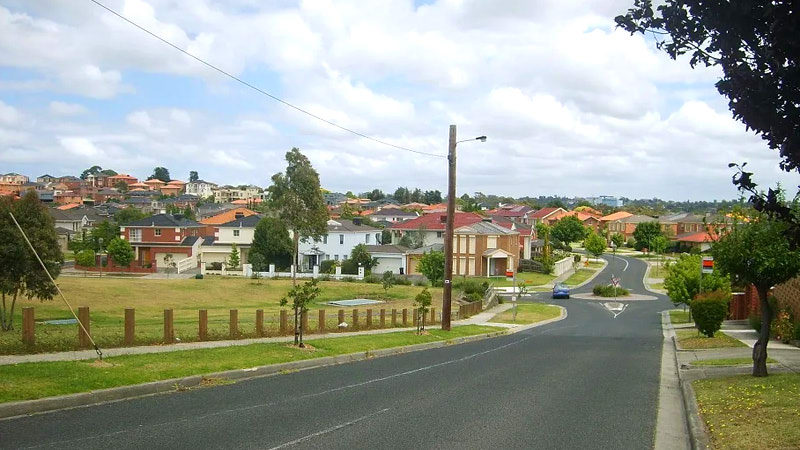Homeowners in Melbourne’s outer suburbs are the most financially stressed across Victoria, with around 500 households at risk of falling behind on their mortgage, credit bureau Illion predicts.
The data shows that as of January, 67% of home loans in Victoria were more than 30 days overdue, which Illion predicts will rise to 70% thanks to the Reserve Bank’s latest 25 basis point rate rise for February.
That figure could rise again to 73% in some areas if we were to see another rate rise this year.

Melbourne’s outer suburbs appear to be most at risk, with 2 or 3 times more households likely to miss their mortgage payments than the national average.
Little River in Melbourne’s west had 2.2% of homes with loans 30 days or more past their due date.
That is expected to rise to 2.3% following this week's rise, and will likely rise again to 2.4% with another subsequent rate rise.
Elsewhere, Dallas and Coolaroo in Melbourne’s outer suburbs in the North have 2.5% of homes that are 30 days or more past their due date.
Over in the outer suburbs to the west, it's a similar story.
The percentage of home loans 30 days or more past their due date currently sits at 2.1% in Yarra Junction, which will likely rise to 2.2% with the February rate hike, and again to 2.3% should the Reserve Bank hike again in March.
Westburn, East Warburton, and Seville also have 1.4-1.9% of mortgage holders who are behind on their mortgages.
Cannons Creek, Fingal, and Red Hill South are among some of the suburbs in Melbourne’s south which all show significant mortgage arrears.
There were also higher delinquency rates in the inner city, apartment-heavy suburbs – including Melbourne, South Melbourne, and Docklands – of 1.3-1.4%.

These suburbs all have something in common
It’s important to note that these outer suburbs have one thing in common - they all have residents who come from a similar socio-economic group.
Key populations for mortgage stress include lower- to mid-socioeconomic areas, regional areas, and younger households that borrowed or refinanced to their maximum earlier in the pandemic.
Many of these households would have been stress tested for rate rises up to 3%, and now rates have surpassed this point they may struggle to continue to meet repayments.
Households in these socioeconomic areas have also likely exhausted their lockdown savings.
At the same time, many of these households are younger Australians or first-home buyers who haven’t held their property for long enough to have accumulated equity.
In contrast, many of Melbourne’s middle suburbs are owned by people who are long-term mortgage owners who have either paid off a significant part of their mortgage or paid it off in its entirety.
Moving forward markets will be fragmented
Moving forward our property market will be much more fragmented than before the boom occurred.
After all, there was never just one Melbourne property market but markets within these markets – there are houses, apartments, townhouses, and villa units located in the outer suburbs, middle ring suburbs, inner suburbs, and the CBD.
And they're all behaving differently.
Why?
Because, as I mentioned above, each different socio-economic and demographic segment across the city is experiencing the rising cost of living differently.
Inflation, higher rent, and higher mortgage costs at a time when wages aren’t rising at the same rate will either prevent first-home buyers from entering the market or restrict their borrowing capacity.
There are many first-home buyers who borrowed to their full capacity and will struggle to make repayments at increasing rates going forward which will restrict capital growth at the lower end of the property market.
Then there are the gentrifying suburbs where more affluent homeowners have established money with higher disposable incomes and who are at minimal or even no risk of defaulting on mortgage repayments even in the face of rising rates.
Only invest in these areas
The fragmented property market across Melbourne means I would only ever recommend investing in the areas where residents’ income is increasing faster than the national average.
These would be the gentrifying suburbs with established money.
That’s because it's these suburbs which are able to withstand fluctuations in the property market and increases in interest rate rises.
These locations typically have higher disposable incomes and people are likely to be prepared to pay a premium to live in a property in one of these locations.
Houses and townhouses in these areas would typically make great investment opportunities.
Most importantly, you need to ensure you invest in an investment-grade property… because while any property can be considered an investment, they don’t all make good financial sense.
What makes a great investment property for me, is not likely to be the same as what would suit your investment needs.
You also need to make sure to invest only in areas where properties hold their value over the long term.
But even before looking for the right location, make sure you have a Strategic Property Plan to steer you through the upcoming challenging times our property markets will encounter.
Aside from remembering that you should focus your efforts on investment-grade properties and locations, you also need to remember that property investing is a process, not an event.
That means that things have to be done in the right order – and selecting the location and the right property in that location comes right at the end of the process.














